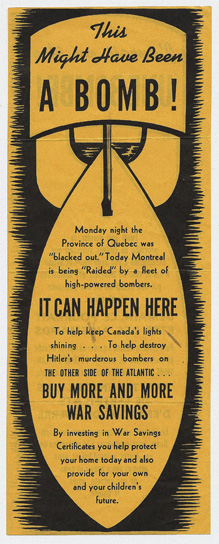

This Might Have Been a Bomb!
This flyer includes references to air raid precaution measures while calling upon Montréalers to invest in War Savings Certificates.
George Metcalf Archival Collection
CWM 19990038-001
|
Life on the Homefront: Montréal, Quebec, a City at War
At the beginning of the Second World War, Montréal was still suffering from the effects of the Great Depression, which had caused widespread unemployment and poverty. Montréal remained Canada’s largest city and a major centre of economic activity, however, with a substantial financial sector and industrial economy. It also had a large labour force, and strategic manufacturing and port facilities located along the St. Lawrence River. Government policy makers used these advantages to meet wartime requirements. Montréal rapidly became a city at war.
Under the direction of the federal government, factories in and around Montréal produced equipment, weapons, and munitions for Canadian and Allied forces. (see Munitions) Workers at companies such as Canadian Vickers, Noorduyn, and later Canadair, built aircraft. The Canadian Pacific Railway’s Angus Shops turned out a range of weapons, including Valentine tanks, while the Montreal Locomotive Works built Ram and Grizzly tanks, and the Sexton self-propelled gun. Employees at Canadian Vickers and United Shipyards built and repaired warships and cargo vessels. Other factories produced essential supplies ranging from uniforms to ammunition. Dominion Industries Limited in Verdun, a city on the edge of Montréal, employed thousands of people and produced more than 1.5 billion rounds of small arms ammunition for Canada and its allies.
Wartime manufacturing created jobs and reduced unemployment. War industries also drew job seekers to the city, increasing demand for limited housing and contributing to crowded living conditions. As elsewhere in Canada and around the world, women entered the paid workforce in increasing numbers, and were also involved in a wide range of volunteer work supporting the war effort. (see Women and the War on the Home Front) Montréal became an even greater transportation and economic hub as weapons and supplies flowed along roads and railways, and down the St. Lawrence River in ships. Aircraft, some built locally, took off and landed at local airports.
The government became an increasing presence in daily life. As the war continued, civilians faced wage and price controls, and the rationing of everyday items, including food. (see The War Economy and Controls) Propaganda urged people to recycle and salvage essential materials, and to contribute to the war effort through programs like Victory Bonds and War Savings Certificates. Civil defence measures, including blackouts and air raid precautions, also became part of life on the home front. Security regulations introduced censorship, affecting many aspects of everyday life, such as newspapers, films, and books. (see Information, Propaganda, Censorship and the Newspapers) The debate about conscription for military service was prominent in Montréal. In 1940, Mayor Camillien Houde was interned for publicly advising Canadians not to register for military service. Politicians, newspapers, and other organized groups from the city’s English- and French-speaking communities argued their positions on conscription passionately and sometimes acrimoniously. (see Conscription)
Personnel in uniform filled the streets, as local men, and later women, joined the military. Montréal and its surroundings were home to a range of military units, including infantry regiments, artillery batteries, and a naval reserve unit. In addition to their hometown units, Montréalers also served with other army units, the Royal Canadian Navy, the Royal Canadian Air Force, or the Merchant Navy. Service personnel from elsewhere in Canada and from other Allied countries were also stationed in Montréal, or sent for training at navy, army, and air force facilities in the city and nearby areas. Still others passed through the city on their way to other parts of Canada or foreign destinations. Ferry Command, based in Montréal, flew more than 9,000 aircraft to destinations around the world and made transatlantic flights a routine event. Montréal, with its well-established reputation for a lively entertainment scene, also attracted military personnel on leave.
Stories about Montréal and its inhabitants, including those serving overseas in the military, form part of the articles from Le Devoir. National and international events, like the debate about conscription or military and diplomatic developments elsewhere in the world, make up many of the other stories presented in the collection.
Articles in French
-
"Des troupes marcheront sur Montréal, dimanche, et occuperont la ville"
Le Devoir, 17/10/1940
-
Dimanche à Montréal. Le défilé militaire. Après la messe pour la victoire
Le Devoir, 07/02/1941
-
"Le maire Raynault demande de décorer, dimanche"
Le Devoir, 07/02/1941
-
La messe votive solennelle Tempore Belli à Notre-Dame
Le Devoir, 10/02/1941
-
L'hommage à Dollard. Au parc La Fontaine et à Carillon. Les manifestation de samedi
Le Devoir, 26/05/1941
-
Cantonnement militaire au pied de la campagne
Le Devoir, 28/05/1941
-
Le camp Jeanne-Mance ouvert au public
Le Devoir, 09/06/1941
-
Le maire Raynault rappelle aux Montréalais leur devoir
Le Devoir, 07/06/1941
-
Montréal reçoit triomphalement le flambeau
Le Devoir, 12/06/1941
-
L'Emprunt. La part de Montréal fixée à $128 millions
Le Devoir, 14/02/1942
-
La récupération. Le comité de Montréal...
Le Devoir, 16/03/1942
-
Les abris souterrains à Montréal
Le Devoir, 27/03/1942
-
Pour nos aviateurs. "Air Force House Montreal"
Le Devoir, 09/06/1942
-
La garnison de réserve. Le soldat Adhémar Raynault. Le maire de Montréal s'est enrôlé...
Le Devoir, 23/06/1942
-
Unité chinoise du C.P.C. à Montréal
Le Devoir, 25/08/1942
-
Nouvelles de guerre. Montréal brillera de tous ses feux comme auparavant. Abolition des restrictions sur l'électricité...
Le Devoir, 26/09/1944
-
"La victoire, à l'hôtel de ville"
Le Devoir, 08/05/1945
-
La métropole canadienne fête bruyamment la victoire
Le Devoir, 08/05/1945
-
Au champ d'honneur de Pointe-Claire
Le Devoir, 26/05/1945
|